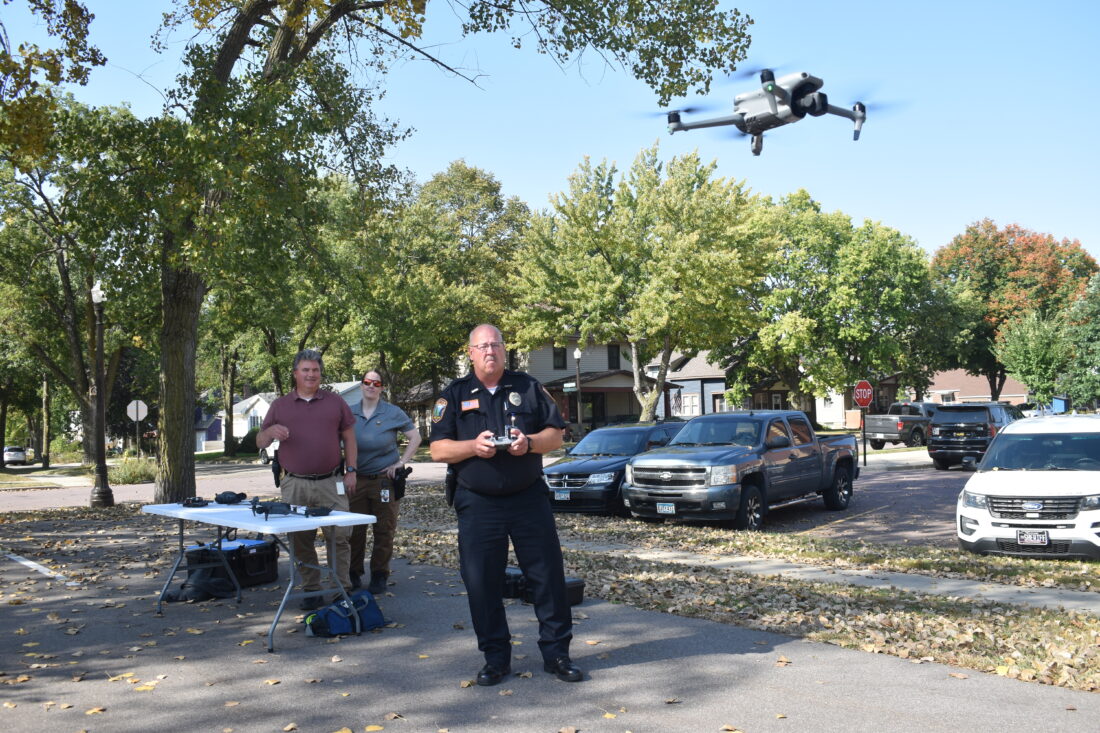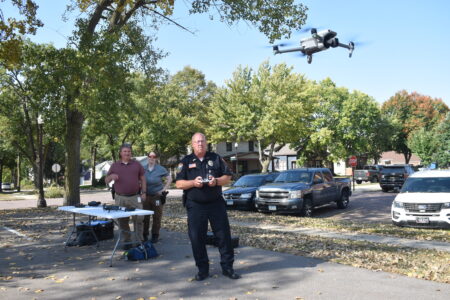Police launch drone program
New Ulm department expands fleet, training

Staff photo by Fritz Busch New Ulm Police Commander Dean Barstad, right, flies a DJI Air 3 practice drone in the Turner Hall parking lot. One of three police department drones, the Air 3 allows drone pilots to refine their skills. Pictured from left are New Ulm Police Department Senior Investigator Chris Moellenhoff and Investigator Tara Martin.
NEW ULM — The police department has extra help in emergency situations these days, in the form of three drones, that can often reach heights and depths much easier and much faster.
“Our Drone Program officially launched in April 2024 with the acquisition of our first drone, the DJI Mavic 3T,” said Senior Investigator Chris Moellenhoff of the New Ulm Police Department. “Since then, we have expanded our fleet with two additional drones — the DJI Air 3 and the DJI Avata 2. Each drone serves a specific purpose and enhances our department’s operational capabilities in unique ways.
According to Moellenhoff, the Mavic 3T is the main drone the police department uses. The primary function of this drone is for search and rescue missions and to help put the fire department as needed.
The drone also has a thermal imaging camera “which is invaluable when locating missing persons and identifying heat sources during fire-related incidents.”
The Air 3 drone is mostly used for training and practice purposes, “allowing our pilots to develop and refine their skills.” Moellenhoff says the drone can be deployed in the field too. The third drone purchased is the Avata 2 which is smaller but mighty. It is ideally used for indoor flight but also quite capable outdoors in certain scenarios.
“It is particularly useful in high-risk building searches, as it provides officers with a safe way to assess interiors before making entry — significantly increasing safety during potentially dangerous operations,” he said.
“We currently have three certified drone pilots, each holding a Part 107 Remote Pilot Certificate issued by the Federal Aviation Administration (FAA),” Moellenhoff explained. “This certification allows them to operate drones for commercial and public safety purposes. In addition, several other officers are actively preparing for their Part 107 exams. Licensed pilots are required to remain up to date on FAA regulations and must complete a recertification test every 24 months to maintain certification.”
Presently, none of the drones have artificial technology (AI) but with thermal imaging and visual stabilization to enhance functionality, the drones are a major hit and make search and rescue missions a bit easier.
“One of the ongoing challenges we face is the time commitment required for training and certification, especially as our personnel balance drone responsibilities with their other duties,” Moellenhoff said. “Despite this, our team remains dedicated to growing their proficiency through regular training and flight practice. Overall, the drone program has proven to be a valuable asset to our department, significantly enhancing our operational capabilities in both emergency response and public safety.”
The equipment costs for each drone paid by public funds include — the DJI Mavic 3T at $5,498 and additional equipment such as speakers, lights, extra batteries, command case with monitor and external power source at $3,816. The DJI Air cost $1,239.98 and the DJI Avata 2 cost $1,935.99.





